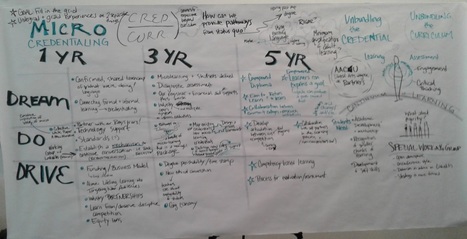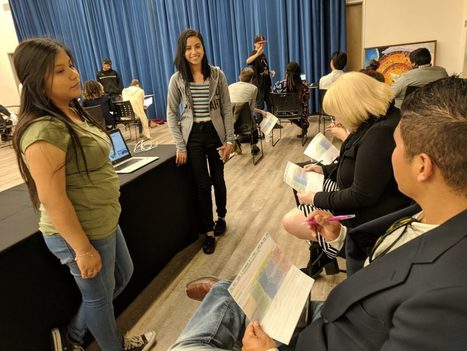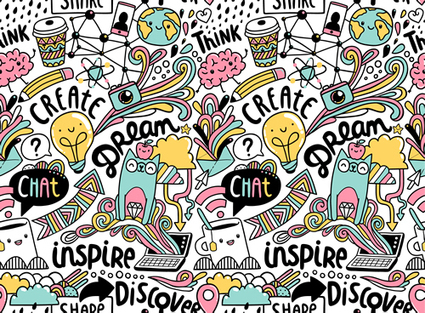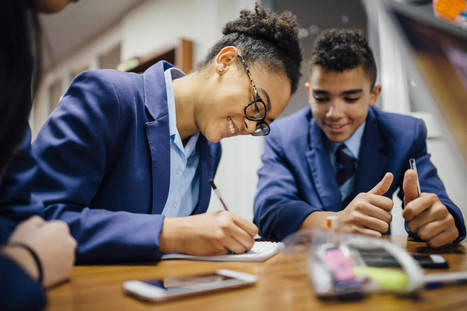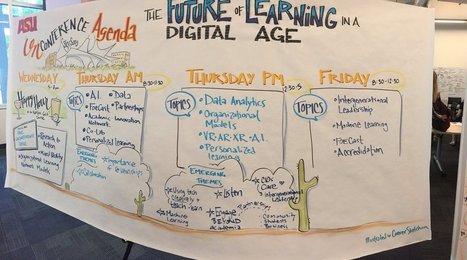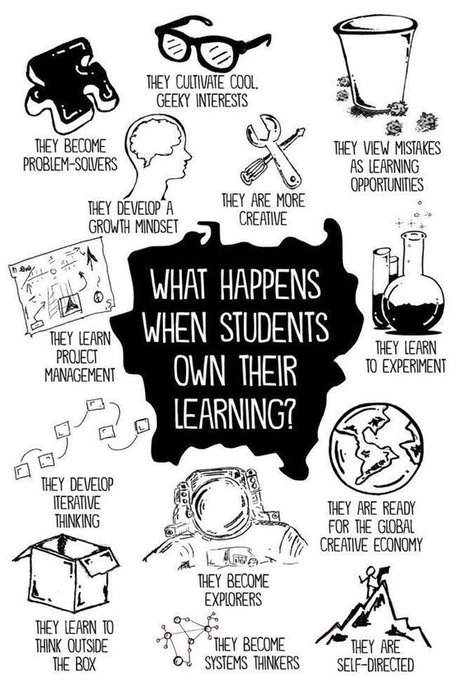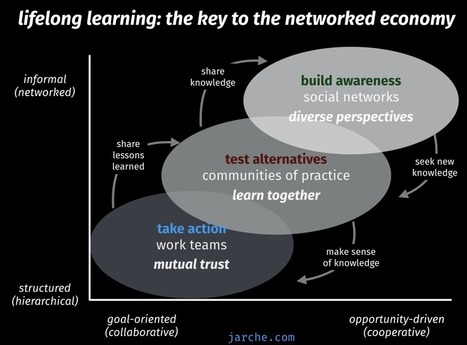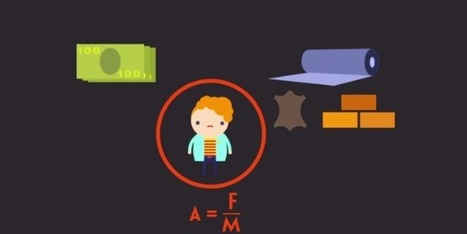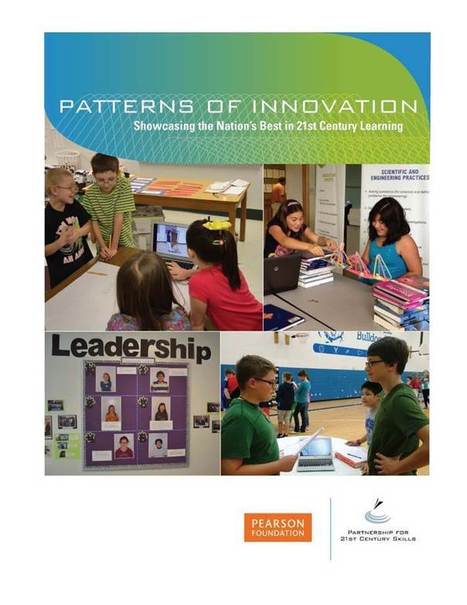 Your new post is loading...
 Your new post is loading...
Innovation is happening all over higher education today—but it is happening in islands, pockets and clusters. Around the country it’s happening a
Guided by the principles of complexity science and working collectively, innovation leaders can and should develop the frameworks that both speak to academic values and help all of us in higher education adapt to a changing context.
Put simply, universities serve two purposes: creating knowledge and sharing knowledge. All Australian unis are currently obligated to create knowledge, and this is unlikely to change dramatically in the future. However, I believe what will change HUGELY is the way knowledge is shared and disseminated to best serve students as they prepare for the future of work. The future of work and the future of higher education are inextricably linked because most students seek university knowledge to improve their employment prospects. The radically different future of work is already here, with: robotics and machine learning taking over programmable human tasks; and more people preferring to contract across different sectors and on varied projects over the course of their working lives. In this environment, workers of the future will need to continually learn new skills – requiring our tertiary sector not just to train people once, for one career, but to deliver lifelong learning.
For me, the fast-paced, very focused micro-credentialing discussion brought together interwoven threads of nearly a half-decade of conversations onsite and online with colleagues—all grounded in recognition that higher education is facing a tremendous challenge in finding/redefining its place in a world that increasingly questions the value of a four-year education and the higher-degree programs that are often extremely expensive and time-consuming. As one colleague mused shortly after the final formal Unconference session ended: Formal education will change radically within 10 years. We don’t stay in a job for five years; why would we stay in college for four? (And while I think there are plenty of great reasons why some of us will continue to see, value, and cherish those four-year experiences with occasional returns to onsite/online formal educational settings, that question is one that is well worth asking of anyone committed to lifelong learning and survival in the sort of rapidly-changing environment that my colleague Jonathan Nalder is attempting to address through his tremendously creative Future-U/First on Mars efforts.)
I didn’t even make it through the hotel lobby to check in before being gratefully and willingly drawn into my first conversation with cherished colleagues here at the Unconference for Dreamers, Doers, & Drivers Shaping the Future of Learning in Tempe and Scottsdale, Arizona Wednesday afternoon. Unexpectedly seeing Jared Bendis, Tom Haymes, and Ruben Puentedura—people…
David Gonski’s report on Australia’s schooling system identifies three key weaknesses and proposes a set of pathways towards improvement.
These weaknesses include decline in student achievement over time, age-based rather than developmental approaches to differentiation in learning goals, and failure to prepare students for a complex and rapidly changing world.
On the third of these issues, the report argues more attention to general capabilities such as problem-solving, social skills and critical thinking is essential in preparing students for an uncertain future.
A zero-sum game?
Early critiques of the report have asserted critical thinking has taken over from knowledge in the latest Gonski review. And also that an increased focus on general capabilities means a decreased focus on knowledge and skills in school subjects such as history and science.
This approach treats the school curriculum as a zero-sum game. More of one thing must mean less of another. What the report actually recommends is a positive-sum. A more structured approach to general capabilities within the established learning areas would better prepare students to succeed in a changing world:
In 2017, only 38% of graduates reported that their educational establishment was mostly at the forefront in adopting innovations, new knowledge or methods (less than the economy average). So how do educational institutions need to adapt in this ever-changing landscape? What are the most important emerging themes and how are other institutions responding?
How do we address innovation in education?
If you want to bring up a kid to be a successful investor or entrepreneur, the current education system says they should be studying STEM subjects, cramming facts and figures, and immersing themselves in coding class. I’ve spent my working life as an entrepreneur and investor – I’ve founded startups, and now invest across Europe for GV (the venture capital investment arm of Google) – but as a father, when I look at the way we’re educating our kids, I think there’s something missing.
Machines are already superintelligent on many axes, including memory and processing speed. Unfortunately, those are the attributes our education system currently rewards, with an emphasis on learning by rote.
Great teaching is at the heart of high-quality personalized learning. Accordingly, one of the best things a school can do to improve the personalized learning experiences of its students is to expand the impact of its highest-performing teachers. Of course, expanding the reach of great teachers is easier said than done–especially when it comes to budget concerns. But a few pioneering schools are strategizing funding for rethinking staffing arrangements and how to organize classes and teaching teams in order to accomplish just that.
Today, in partnership with Public Impact, we’re excited to publish the final four case studies showcasing schools that utilize innovative staffing arrangements in conjunction with blended learning to further support educators and amplify the impact of their teachers.
The first set of case studies was released March 14.
None of this means that disciplines are no longer important, or are slated for redundancy. But if we are to tackle the most difficult societal and research challenges, it is clear that the grip that disciplinary culture has on universities must be relaxed somewhat. The shape of research is changing. The most successful universities of the 21st century will be those that respond creatively to these new demands and opportunities.
There is a deep mismatch between the skills our education systems nurture and the needs of society.
In a typical Western education system, results indicated that “since 1990, even as IQ scores have risen, creative thinking scores have significantly decreased”. Traditional education does not sufficiently value innovative and entrepreneurial thinking — our system even dumbs down the creative genius that we were born with, according to a test developed by NASA.
Yet creative skills and mindsets are indispensable in a workforce that must be responsive to change and capable of finding new solutions to complex problems. The World Economic Forum itself has identified social abilities such as coordinating with others and persuasion, as well as complex problem-solving skills, as essential in the knowledge-based workplace of the near future.
We live in the times of autonomous cars, reusable rockets and artificial intelligence, yet we are still teaching in an education system that was set up for factory workers some 200 years ago. What we should be doing instead is to focus on skill-building and setting any learner — be it in compulsory education or in lifelong learning — up for success.
What’s fueling the student experience at one of the country’s aptly named “super schools”? In part, blended learning is helping to unlock a wholly new approach to high school.
At Da Vinci RISE High School, a new charter school headquartered in Hawthorne, California (and a 2016 XQ: The Super School Project grant recipient), the student experience marks a 180 from traditional schooling. RISE High students—many of whom come to the school experiencing housing instability, are in the foster care system, are severely credit-deficient, or have previously been homeschooled—need the right combination of an alternative, flexible learning environment and strong relationships to thrive as young adults. And that combination defines RISE High’s blended model.
What the school did instead was to add six hours of music per week for every student, and the results have been stunning:
The school is in the top 10% nationally for pupil progress in reading, writing and maths.
74% of its kids met the nation’s reading standard, higher than the national average of 53%.
74% of its pupils achieved the expected standard in reading, writing and maths, compared to a national average of 53%.
Feversham students are 7.1 points above the national average for reading and 3.4 for writing.
Feversham students are 6.5 points above the national average for math.
The school’s results for disadvantaged pupils are well above average.
|
Creativity in the classroom provides a more relaxed and open environment for the students to freely express their opinions and to learn faster. Here are some tips for helping teachers add creativity to the curriculum.
Reverse planning for challenging assignments is more effective than forward planning for a few reasons, the researchers noted. For one, it helps the planner consider critical steps and then identify likely obstacles—all from the point of view of having completed the goal, which sharpens clarity. “When visualizing the endpoint, things seem clearer and more positive,” said William Hedgcock. “If you start at the present, you could go this way or that way—it can be more negative,” he added, because of the multiple possible steps to be taken. Backward planning also kickstarts motivation at the time when inspiration lags most, during the middle of a goal pursuit. Finally, backward planning from an imaginary finished goal lessened the perception of time pressure.
Let me sum up, given a few day’s distance and reflection.
People generally liked the FOEcast idea. There’s a hunger for forecasting work concerning education and technology. There’s also a desire to experiment with new approaches.
The consensus was overwhelmingly in favor of an open, transparent, and networked approach. Nobody argued for a project that runs dark, or works in isolation. Many people insisted on a project that includes multiple populations, educational sectors, and nations.
I think this was the first time we’ve heard requests to involve students.
Some of FOEcast’s questions remained unaddressed. Beyond one or two mutterings about Delphi, there were no suggestions as to futuring methodology. There wasn’t a sense of what a product or services should look like, beyond the discussion kit.
One of the most interesting findings was the sense that FOEcast should partner with organizations, be they universities, nonprofits, or companies. People from each of these approached me, by the way.
One of the more playful and productive exercises at the Unconference for Dreamers, Doers, & Drivers Shaping the Future of Learning in Tempe and Scottsdale, Arizona late last week involved building neighborhoods. We weren’t using hammers and nails, and no hardhats were required. This was an exercise in identifying key issues in higher education and other learning environments; pulling tables together to create neighborhoods of conversation within the conference room in which we were meeting; and then diving into those conversations designed to identify what the residents of the newly-established Unconference neighborhoods held as their unifying dream, what we hoped to do in one-, three-, and five-year periods (horizons, anyone?) of time, and what was driving us toward those dreams and actions.
Higher education gatherings seem to be evolving away from conferencing and towards unconferencing.
We may get to the point where we drop the “un” in “unconference”, much like we’ve dropped the digital from digital from photography. (Come to think of it, we should probably drop the “digital” from digital learning as well - it is all just learning).
Last week I attended an ASU unconference on the future of learning in the digital age. The best place to catch up with what was discussed at the event is probably by scrolling through #shapingedu.
What happens when students own their own learning? It turns out that when students take control of their own learning, they gain a whole host of benefits. So what are they? Check out the graphic below to find out.
We live in a network society. It is now possible to find mentors, fellow seekers, or knowledge catalysts in almost any field. The only constraints are time and some guidance. Faculty should be able to model the behaviours of engaged network learners. If they cannot, they should not teach. Students can learn through cognitive apprenticeship, connecting to external communities and professional networks over the course of their studies.
Why are universities and colleges not doing this? Because they feel they do not have to. They may throw in a course or two on professional development but this is often at the end of studies, when it’s a bit late to start building a network and a body of professional knowledge.
Creativity has become a coveted skill as the world's problems get bigger and more complex. Many schools recognize creativity as an important part of learning as well, but struggle to inject it into classrooms that are often dictated by district-mandated curriculum and focused on a narrow set of success criteria. But the challenges schools face could also be grounds for modeling the type of creativity teachers want to see in students.
"Constraints aren't the boundaries of creativity, but the foundation of it," according to Brandon Rodriguez in a TED-Ed video on the creative power of limitations. Constraints are an essential part of scientific experimental design and have driven discoveries in engineering and other fields as well. Too often "creativity" is associated only with art or aesthetics, but there is evidence of creativity in many day-to-day activities.
P21 has teamed with the Pearson Foundation to capture and share exemplary 21st century learning practices that are improving schools, student learning and opportunities in classrooms and communities across the United States.
In addition to identifying, documenting, sharing and celebrating the 21st century practices of exemplar schools we are reporting on the broader common features– the Patterns of Innovation– that emerge across exemplar schools and appear to be at the heart of their effective transformation into 21st Century Learning Environments.
Tech giants recognize the creativity within this ecosystem. It is in their interest, as well as wider society’s, to preserve it. From Imperial College alone, we’ve seen virtual reality start-up Surreal Vision snapped up by Facebook’s Oculus, audio detection start-up, Sonalytic bought by Spotify, and machine learning image recognition firm, Magic Pony acquired by Twitter. It is doubtful whether these innovations could have emerged from in-house R&D. The university was indispensable.
This plural wave of innovation has nimble start-ups, academics and tech giants driving change. The AI revolution is set to keep benefiting society as a whole. Universities must remain at its heart.
Online mentoring may sound like an oxymoron. Can an online connection really can stand up to enduring face-to-face relationships we enjoy with close mentors? Indeed, there’s scant evidence to suggest that an online mentor is better than a face-to-face mentor.
But our research into technology tools designed to connect students to online mentors tells a different story. The upside of online mentoring is its unique ability to fill gaps in students’ networks. Rather than attempting to replace strong relationships in students’ analog lives, these models promise to offer new online connections in circumstances where students’ current alternative is nothing at all. Using technology, online mentoring programs can allow students who otherwise might never meet an engineer or lawyer to connect with working professionals. They can fill advice gaps for those students with shockingly limited access to college guidance in high school. They can step in to encourage and motivate students learning in isolation to persist when curiosity waivers, providing a gentle nudge to press onward.
The idea is to test big assumptions on which the success of a plan hangs as cheaply and quickly as possible to mitigate risk. Fast failure that doesn’t cost a lot or expend a lot of political capital is a success. And it allows you to iterate and refine a plan if there’s still a viable path forward.
Innovation is a difficult and unpredictable process. But it is a process—and not simply an event—that universities can manage. The rewards for doing so can be significant, with the opportunity to grow an institution’s impact long into the future.
|

 Your new post is loading...
Your new post is loading...
 Your new post is loading...
Your new post is loading...






